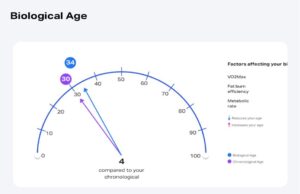At MOOV Utah, we integrate evidence-based strategies to enhance metabolic health, longevity,
and performance. One of the cornerstone approaches we employ is Zone 2 training, a highly
effective method for improving VO2 max and accelerating fat loss. When paired with tailored
supplementation and advanced therapies like GLP-1 receptor agonists (Ozempic & Tirzepatide),
the results are remarkable.
This case study details the progress of a 30-year-old client who saw substantial improvements in body composition and cardiovascular fitness through a personalized plan that integrated these elements.
Why Zone 2 Training is Essential
Zone 2 training involves exercising at 60-70% of maximum heart rate, a range that primarily
burns fat as fuel. This method enhances mitochondrial function, boosts aerobic efficiency, and
promotes sustainable fat loss. At MOOV Utah, we begin by assessing VO2 max to help clients
determine their actual Zone 2 range. In this case, the client’s calculated Zone 2 based on age was 119-133 bpm, but testing revealed that his actual Zone 2 was significantly lower. Training in the calculated range would have placed him in Zone 3, which does not provide the necessary
adaptations for fat loss or improved aerobic capacity, and would have significantly delayed his
progress.

Client Progress and Adjustments
Initial Strategy (January 2024):
Given his morbid obesity and deconditioned aerobic state, along with a very low VO2 max for
his age, we focused on building a cardiovascular base through exclusive Zone 2 training. We
advised the client to engage in 30-60 minutes of Zone 2 exercise (walking, cycling, or using an
elliptical) 3-5 days a week. He also started a low-dose Tirzepatide regimen in January 2024 to
support satiety and fat loss. By month five, he had ramped up to a maximum dose of 5 mg
weekly before beginning a gradual reduction, currently tapering to 4.5 mg per week, based on
weight loss and satiety. These represent relatively low doses of GLP-1 agonists for the nearly 70
pounds of weight loss achieved over nine months.

Body Composition Changes (January 2024 – October 2024):
This comprehensive approach resulted in the client’s weight dropping from 272 lbs in January
2024 to 206 lbs by October 2024—a remarkable 65+ pounds lost with minimal muscle loss. In
July 2024, we began tracking visceral fat mass (previously unavailable to this client) and noted
a 25% reduction in visceral fat volume from July to October. Reducing visceral fat, which is
linked to metabolic diseases, had a significant impact on his overall health. Muscle loss was
further minimized with the addition of sermorelin.

VO2 Max Progression and Training Adjustments
• December 2023 (270 lbs): VO2 max of 31
• June 2024 (230 lbs): VO2 max of 37
• October 2024 (205 lbs): VO2 max of 43

We began the program with 100% Zone 2 training and later incorporated a 90/10 split between
Zone 2 and Zone 4, the client achieved an impressive VO2 max increase to 43 by October 2024.
Impact on All-Cause Mortality Risk
Research consistently shows that improvements in VO2 max are strongly linked to reduced all-
cause mortality. Studies suggest that every 1 MET increase in VO2 max corresponds to a 10-
15% reduction in all-cause mortality risk.
VO2 Max Conversion to METs:
1 MET = 3.5 mL/kg/min of VO2
• Initial VO2 max: 31 mL/kg/min
• Final VO2 max: 43 mL/kg/min
This increase results in a calculated improvement of 3.43 METs. Based on this, the reduction in
mortality risk ranges from 34.3% to 51.5%.


Risk Reductions for Cardiovascular Disease, Diabetes, Hypertension, and Cancer
The increase in VO2 max also dramatically decreased the client’s risk of various diseases:
• Cardiovascular disease risk: Reduced by 51.5% to 102.9% (noting that a >100%
reduction is unlikely, but this demonstrates the profound benefits).
• Type 2 diabetes risk: Reduced by 24% to 34.3%.
• Hypertension risk: Reduced by 41.2%.
• Cancer mortality risk: Reduced by 17.2% to 34.3%.
Visceral Fat Reduction and its Health Impacts
While visceral fat data was unavailable at the start of the program, we estimate that the client
experienced over a 50% reduction in visceral fat mass. Objectively, we measured a 25%
reduction from July to October 2024, which has substantial health benefits, including a 20-30%
reduction in cardiovascular disease risk, improved arterial health, and more favorable lipid
profiles.
Summary of Health Impacts from a 25% Reduction in Visceral Fat:
• Cardiovascular disease risk: Reduced by 20-30%
• Type 2 diabetes risk: Reduced by 20-30%
• Metabolic syndrome risk: Reduced by 20-25%
• Blood pressure: Decreased by 5-8 mmHg systolic, 3-5 mmHg diastolic
• Inflammatory markers: Reduced by 15-20%
• Cancer risk: Reduced by 15-20%
• NAFLD (non-alcoholic fatty liver disease) risk: Reduced by 20-30%
• Hormonal balance: Improved by 20-25%
• Cognitive decline risk: Reduced by 15-20%
At MOOV Utah, our use of VO2 max testing and heart rate-specific training allowed this client
to achieve transformative results with a simple, actionable plan. His improvements in VO2 max
have led to a significant reduction in the risk of death from various causes. Even in the event of
traumatic injury, his increased fitness will improve his chances of survival and recovery. His risk
of developing diabetes and hypertension has dramatically decreased, and his overall health is
vastly improved.
………………………………………………………………………………………………………………………………………………………….
References
1. Ross R. et al., Assessing Cardiorespiratory Fitness in Clinical Practice, 653-699.
2. Brewer C.P. et al., Effect of Sodium Phosphate Loading on VO2 Peak, 187-194.
3. Kuwabara A.M. et al., Iron Deficiency in Athletes, 620-642.
4. Perez J.M. et al., The Effects of Beetroot Juice on VO2 Max, 332-342.
5. Antunes B.M. et al., Sleep Quality and Duration Associated with Performance, 252-256.
6. Berge J. et al., Cardiorespiratory Fitness and Weight Loss in Severe Obesity, 69.
7. Forman D.E. et al., Cardiopulmonary Exercise Testing, 68-86.
8. Buckley J.D. et al., Long-Chain Omega-3 Polyunsaturated Fatty Acids for Reducing Obesity, 1212-1230.
9. Tabrizi R. et al., The Effects of Caffeine Intake on Weight Loss, 2688-2696.
Longevity
Subscribe to our newsletter to get the latest updates.




